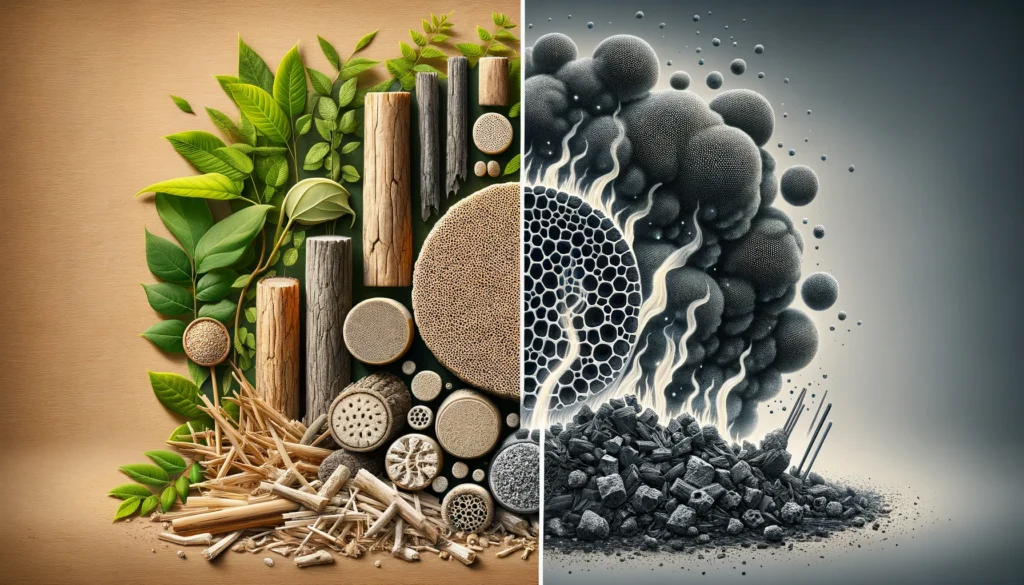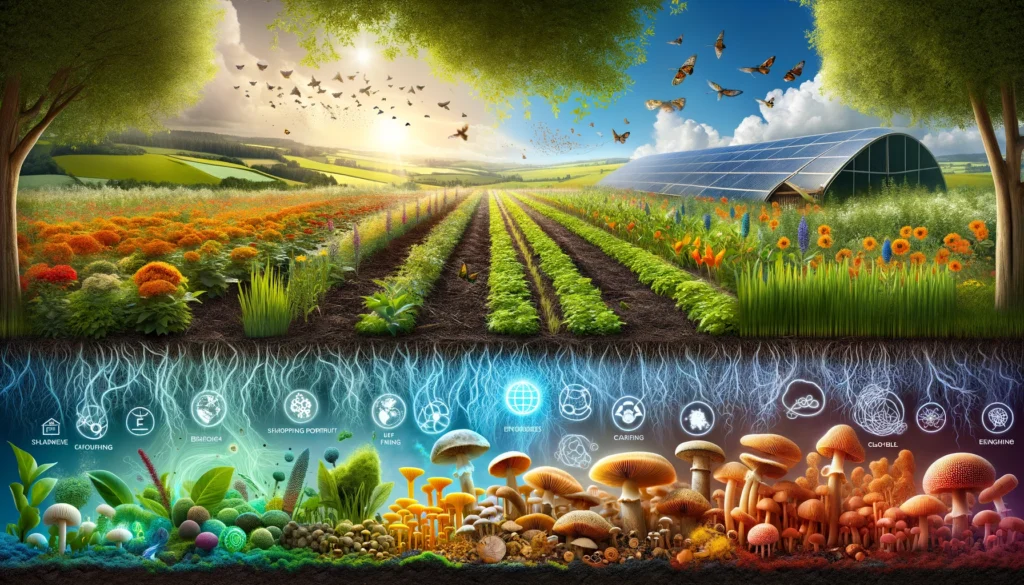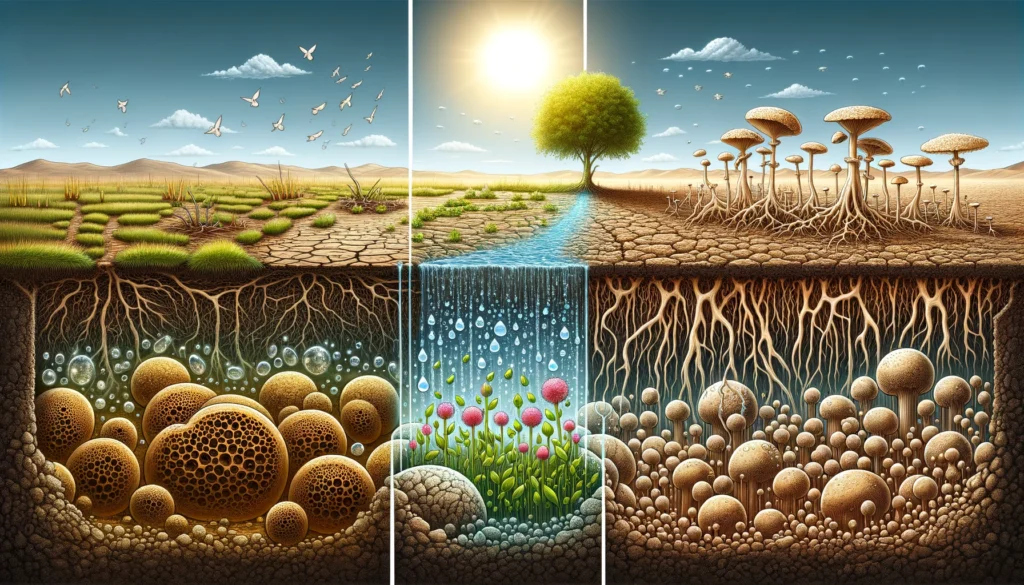Welcome to the fourth blog of our series – “Biochar & Fungi: Earth’s Green Guardians“
In our ongoing journey through “Eco-Fungi: Earth’s Climate Fix,” we’ve explored the incredible roles fungi play in our ecosystems. Today, we delve into an exciting synergy between biochar and fungi, a combo that’s sparking interest for its potential to revitalize soils and combat climate change. This chapter will simplify the complex science behind biochar and show how fungi amplify its benefits, creating a sustainable solution for our planet’s future.
What Is Biochar?
Imagine taking plant waste, such as leaves, wood, and other natural materials, and cooking them without much air. This special cooking process is called pyrolysis. It’s like baking a cake in an almost closed oven, keeping most of the air out. What you get from this process is not a cake, but something called biochar. Biochar looks a bit like charcoal, but it’s full of tiny holes. These holes give biochar a special ability to hold onto things like water and nutrients.

Biochar is interesting because it’s very stable, meaning it doesn’t break down or disappear quickly in the soil. It can stay in the ground for hundreds, even thousands, of years. This stability makes biochar a powerful tool for keeping carbon—a major part of plants that can turn into carbon dioxide, a greenhouse gas—locked away in the soil instead of letting it go into the air and contribute to climate change.
Fungi’s Role in Enhancing Biochar Benefits
Now, let’s add fungi to the biochar story. Fungi are like the internet of the soil, connecting different parts of the soil and plants through their network of threads, called mycelium. When biochar is added to the soil, it’s like building a bunch of new houses for the fungi. The fungi move in and spread their mycelium through the tiny holes in the biochar, making their network even bigger and stronger.

This partnership between biochar and fungi does a few amazing things for the soil and plants:
- Better Nutrition for Plants: The fungi use their network to gather water and nutrients from the soil and deliver them directly to the plant’s roots. The biochar makes this process even better by holding onto nutrients that the fungi can then pick up and transport. This means plants get more of the good stuff they need to grow strong and healthy.
- More Water When Needed: Just like biochar holds onto nutrients, it also holds onto water. Fungi can help distribute this water to the plants, especially during dry times. This makes plants more resilient to drought and reduces the need for watering.
- A Happier Home for Soil Life: The biochar not only houses fungi but also creates a better environment for other helpful soil organisms. This bustling underground community helps keep the soil healthy and full of life, which is great for growing plants.
By working together, biochar and fungi supercharge the soil, making it a better place for plants to grow and helping our planet by locking away carbon. It’s a win-win for agriculture and the environment.
The Sustainability Supercharge
The collaboration between biochar and fungi in the soil is like a sustainability supercharge, transforming the way we approach environmental restoration and climate mitigation. This dynamic duo revitalizes the soil, making it more fertile and productive, which directly benefits agricultural practices and ecosystems. Here’s how this partnership creates a ripple effect of sustainability:

- Boosting Plant Health: Biochar improves soil structure, which in turn supports fungi growth. Fungi help plants absorb nutrients more efficiently, leading to healthier, more robust crops. This natural boost reduces the need for chemical fertilizers, which are energy-intensive to produce and can harm the environment.
- Carbon Capture: Perhaps the most significant benefit of biochar is its ability to store carbon in the soil for hundreds of years. This process directly tackles one of the root causes of climate change by removing carbon dioxide from the atmosphere. The presence of fungi enhances this process, as they contribute to the soil’s organic matter, further increasing carbon storage.
- Supporting Biodiversity: Healthy soil supports a diverse ecosystem, from microorganisms to plants and insects. By enhancing soil fertility and structure, biochar and fungi create a habitat where biodiversity can flourish. This biodiversity is essential for resilient ecosystems that can withstand pests, diseases, and climate fluctuations.
Aiding in Water Retention
Water scarcity is a growing concern worldwide, particularly in areas prone to drought. Here, the biochar-fungi partnership offers a compelling solution by significantly improving soil’s water retention abilities. This not only conserves water but also ensures plants have access to moisture during dry periods:

- Water Storage: The porous nature of biochar acts like a sponge, absorbing water and holding it within the soil. This property is crucial for maintaining moisture levels in drylands, reducing the need for frequent irrigation, and helping to conserve water resources.
- Efficient Water Use: Fungi play a crucial role in distributing stored water throughout the soil, ensuring that it reaches the roots of plants. This efficient use of water supports plant growth even in challenging conditions, making agriculture more resilient to drought and reducing water wastage.
- Soil Structure: Beyond its immediate benefits for water retention, biochar also improves soil structure over time. Better soil structure means enhanced porosity and permeability, which further improves the soil’s ability to capture and store water. This creates a positive feedback loop, where improved soil health leads to more efficient water use and less vulnerability to erosion and runoff.
Together, biochar and fungi are pivotal in creating more sustainable agricultural landscapes, reducing our carbon footprint, and adapting to the challenges of water scarcity. Their combined action in enhancing soil health, carbon sequestration, and water retention exemplifies the kind of innovative, nature-based solutions we need to embrace for a sustainable future.
Author’s Note
As we unravel the potential of biochar and fungi to revolutionize sustainable farming and tackle climate change, it’s clear that these natural solutions hold untapped potential. By embracing and researching these methods further, we can uncover new pathways to restore our planet’s health and secure a greener future for generations to come.
G.C., Ecosociosphere contributor.
References and Further Reading
- “The Biochar Solution: Carbon Farming and Climate Change” by Albert Bates – Delve into the science of biochar and its potential to combat climate change.
- “Mycelium Running: How Mushrooms Can Help Save the World” by Paul Stamets – Explore the fascinating world of fungi and their environmental benefits.
- “Dirt: The Erosion of Civilizations” by David R. Montgomery – Understand the crucial role of soil in human history and its potential future impact.
Stay tuned for our next blog, where we’ll continue to explore innovative natural solutions to environmental challenges, focusing on the role of fungi in waste decomposition and pollution reduction.





Comments
Thank you for your sharing. I am worried that I lack creative ideas. It is your article that makes me full of hope. Thank you. But, I have a question, can you help me?
Can you be more specific about the content of your article? After reading it, I still have some doubts. Hope you can help me. https://www.binance.com/zh-TC/register?ref=VDVEQ78S
I don’t think the title of your article matches the content lol. Just kidding, mainly because I had some doubts after reading the article.
Your point of view caught my eye and was very interesting. Thanks. I have a question for you.
Your article helped me a lot, is there any more related content? Thanks!
Your point of view caught my eye and was very interesting. Thanks. I have a question for you.
I don’t think the title of your article matches the content lol. Just kidding, mainly because I had some doubts after reading the article.
I don’t think the title of your article matches the content lol. Just kidding, mainly because I had some doubts after reading the article.
Your point of view caught my eye and was very interesting. Thanks. I have a question for you.